|
THREATS TO RIVER ECOSYSTEMS OF UTTARA KANNADA
Dams: Large to small sized dams used for hydroelectricity production and small size local check dams for intense agriculture purposes (Figure 7). Both large and small check dam affects the riverine biodiversity and water quality. Removal of riparian vegetation is observed in all river basins (figure 7). In particular streams flows next to the agriculture lands shows significant removal of riparian vegetations.
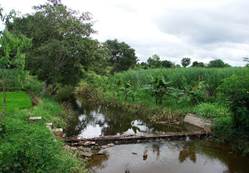 |
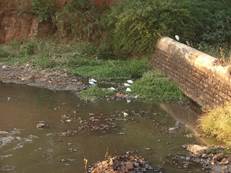
|
Figure 7: check dam and loss of riparian vegetation. Site: Beegar, Yellapura |
Figure 9: Site showing sewage flowing in tributary of Bedthi |
Water pollution due to domestic sewage: Bedthi River Basin, in particular upper reaches of Bedthi shows high level of water quality degradation due to the domestic sewage disposal in the main streams (Figure 9). Certain portion of the domestic sewage of Hubli town is disposed into upper Bedthi River (Figure 10). Sewage contaminants flows in to Bedthi River and later gets diluted by the water from tributary like Hasehall, which drains more water even during the summer months. Some of the sites, which are severely affected by the water pollution in Bedthi River basin are Sangadevarakoppa, Kalghatghi and Manchikeri (Yellapura).
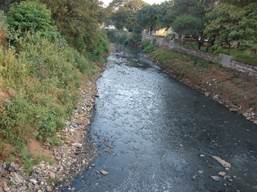
|
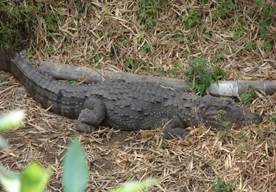
|
Figure 9: sewage inflow in the tributary of Bedthi |
Figure 10: Mugger crocodile (Crocodylus palustris) in Kervada, Paper Mill effluent confluence point in Kali River Basin |
Industrial Pollution: Kali River Basin is under the influence of industrialization in Uttara Kannada, in particular Dandeli region with polluting industries. The West Coast Paper Mills Ltd situated in the bank of River Kali pollutes the water and surrounding riparian environment by letting partially treated or untreated effluents into the river. Kervada village, next to Dandeli witness severe water and air pollution due to the effluent of paper mill. Paper mill waste increases total dissolved and suspended solids, turbidity and ionic content. In addition to the effluents the river also receives sewage. Organic waste let in to the river decreases the dissolved oxygen, which eventually causes threat to aquatic biodiversity. Site where confluence of sewage is also witnessed soaring population of Mugger crocodiles (Figure 10) resulting in the higher instances of human wildlife conflicts.
Sand Mining: Sand mining is one of the common problems observed in lower reaches of all the river basins (Figure 11). Sand mining is predominant in brackish water region of Kali and Sharavathi River Basins, where mechanized sand mining is in practice for a while. Sand mining cause severe threat to the benthic organisms. Most of the marine and esturine benthic organisms breed in brackish regions faces severe threat due to the mechanized sand mining. Mangrove regions in Kali estuary is also threatened by sand mining due to loss or alteration of habitat.
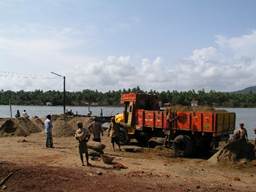 |
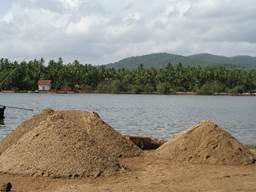
|
Figure 11: Mechanized sand mining in Kali River Basin |
Table 2 lists the river basin wise threats with the appropriate mitigation measures to enhance the functional aspects of aquatic ecosystems.
Table 2: Threats and Mitigation Measures
River Basin |
Region |
Problem |
Remedial Measures |
Kali |
Dandeli |
Paper mill effluent |
Enforce effluent treatment by the industry (implementation of the control of water pollution, Polluter pays principle) |
Kali |
Ramnagar |
Non-point source pollution in
streams and rivers from Agriculture fields |
Avoiding intense use of chemical fertilizers and pesticides |
Kali |
Honkon (Brackish) |
Mechanized sand mining |
Stopping of sand mining in certain ecologically sensitive region and regulated sand mining in selected localities |
Bedthi |
Sangdevarkoppa |
Non-point source pollution |
Avoiding intense use of chemical fertilizers and pesticides |
Bedthi |
Kalghatghi |
Urban domestic sewage, non-point source pollution |
Implementation of sewage treatment plant in Hubli town. Sewage should be treated before letting in to the river. |
Bedthi |
Kalghatghi |
Solid Waste Disposal in River |
Setting up Solid waste treatment and landfill facility in outskirts of Hubli town. |
|
Manchikeri |
Urban domestic sewage, non-point source pollution |
Implementation of sewage treatment plant in Hubli town. Sewage should be treated before letting in to the river. |
Sharavathi |
Gerusoppa and downstream |
Mechanized sand mining |
Stopping of sand mining in certain ecologically sensitive region and regulated sand mining in selected localities |
References
- Ramachandra T V, Subash Chandran M.D., Joshi N V, Karthick B and Vishnu D. Mukri, 2015. Ecohydrology of Lotic Ecosystems of Uttara Kannada, Central Western Ghats, In: Ramkumar, M., Kumaraswamy, K. and Mohanraj, R. (Eds.). Environmental management of River Basin ecosystems, Springer Earth System Sciences, DOI 10.1007/978-3-319-13425-3_29
- Ramachandra, T.V. 2014. Hydrological Responses at Regional Scale to Landscape Dynamics, J Biodiversity, 5(1,2): 11-32.
|
T.V. Ramachandra
Centre for Sustainable Technologies, Centre for infrastructure, Sustainable Transportation and Urban Planning (CiSTUP), Energy & Wetlands Research Group, Centre for Ecological Sciences, Indian Institute of Science, Bangalore – 560 012, INDIA.
E-mail : tvr@iisc.ac.in
Tel: 91-080-22933099/23600985,
Fax: 91-080-23601428/23600085
Web: http://ces.iisc.ac.in/energy
Vinay S.
Energy & Wetlands Research Group, Centre for Ecological Sciences, Indian Institute of Science, Bangalore – 560 012, INDIA.
E-mail: svinay@iisc.ac.in
Bharath Settur
Energy & Wetlands Research Group, Centre for Ecological Sciences, Indian Institute of Science, Bangalore – 560 012, INDIA.
E-mail: setturb@iisc.ac.in
Bharath H. Aithal
Energy & Wetlands Research Group, Centre for Ecological Sciences, Indian Institute of Science, Bangalore – 560 012, INDIA.
E-mail: bharathh@iisc.ac.in
Citation: Ramachandra T V, Vinay S, Bharath Settur and Bharath H. Aithal, 2017. Profile of Rivers in Karnataka, ENVIS Technical Report 129, Sahyadri Conservation Series 71, Energy & Wetlands Research Group, CES, Indian Institute of Science, Bangalore 560012
| Contact Address : |
| |
Dr. T.V. Ramachandra
Energy & Wetlands Research Group,
Centre for Ecological Sciences, Indian Institute of Science, Bangalore – 560 012, INDIA.
Tel : 91-80-23600985 / 22932506 / 22933099
Fax : 91-80-23601428 / 23600085 / 23600683 [CES-TVR]
E-mail : tvr@iisc.ac.in, energy@ces.iisc.ac.in,
Web : http://wgbis.ces.iisc.ac.in/energy |
|